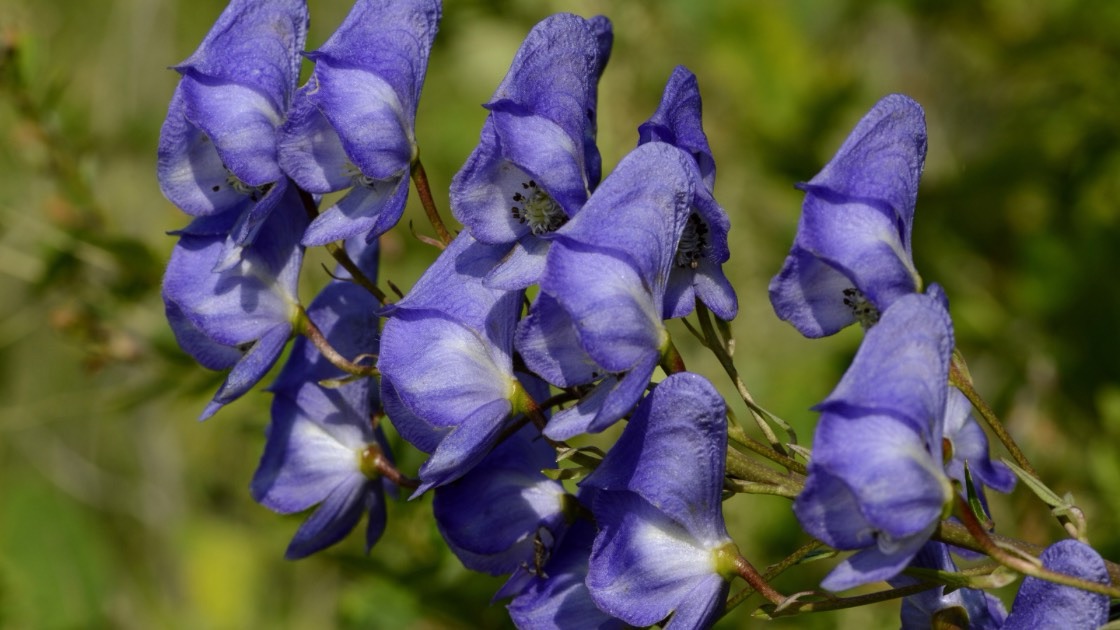Wolfsbane was used as protection against werewolves and vampires
In European folklore, wolfsbane was believed to protect against werewolves and vampires. Others believed that touching wolfsbane on a full moon could cause shape-shifting. Historically, wolfsbane was used in small doses to treat patients who had delusions of being a wolf. It was also said to be used to treat pain and fever. Wolfsbane is highly toxic and can be fatal if ingested. The name comes from when ancient Greeks hunted wolves by poisoning their bait with this plant.

Deadly Nightshade was thought to allow witches to fly or enter trances
In European folklore, Deadly Nightshade was thought to allow witches to fly or enter trances. Also known as belladonna, it was used historically as a sedative and muscle relaxant. Deadly Nightshade contains atropine which is used in modern medicine as an antidote for certain types of poisoning.

Mugwort was believed to keep witches away and was worn as an amulet to ward off danger
In European folklore, mugwort was believed to keep witches away. In ancient Rome, it was worn as an amulet to ward off danger. Medically, mugwort has been used to stimulate digestion, reduce menstrual pain, and as a sleep aid.

Mandrake was said to scream when pulled from the ground and was believed to hold magical powers due to its human-like root shape
In European and Middle Eastern folklore, mandrake was said to scream when pulled from the ground and its human-like root shape was thought to be a source of magic. Historically, mandrake was used as an anesthetic for surgery and as a sedative. However, it is toxic. Don’t do this.

“Devil’s Trumpet” or datura was used by witches to induce visions and out-of-body experiences
Also known as “Devil’s Trumpet” or “Jimsonweed,” datura has a strong association with witches and was believed to induce visions and out-of-body experiences. Datura was historically used in various cultures to treat asthma, pain, and muscle spasms. Datura is highly toxic and hallucinogenic and should not be used.

In Celtic and English folklore, the yew tree is believed to harbor the souls of the dead and is often found in graveyards
In Celtic and English folklore, the yew tree is associated with death and the underworld. It is often found in graveyards as a symbol of eternal life. It was believed that the yew tree would harbor the souls of the dead. The yew tree is the source of paclitaxel (Taxol), a chemotherapy drug used to treat cancer.

In medieval Europe, henbane was said to help witches fly and was used in potions for inducing visions.
In medieval European folklore, henbane was said to help witches fly and was used in potions for inducing visions. Historically, henbane was used as a sedative, painkiller, and to treat respiratory issues. Henbane contains toxic alkaloids and shouldn’t be used.

Rue was used to ward off the “evil eye” and used in rituals for its protective properties
Rue was regarded as a powerful protective herb in ancient Roman and medieval European folklore. It was used to ward off the “evil eye” and was also used in rituals for its protective properties. Rue has been used for headaches, muscle pain, and digestive issues. It also has properties that reduce anxiety and inflammation.

In ancient Greek and Roman folklore, thyme was burned to ward off evil spirits
In ancient Greek and Roman traditions, thyme was burned to ward off evil spirits. It was also placed under pillows to promote peaceful sleep and protect from nightmares. Today, thyme is used as an antiseptic, antibacterial, and in respiratory treatments. It has also been used to aid digestion and relieve coughs.

Witch hazel was believed to have magical properties including the ability to ward off evil spirits
Witch hazel was believed to have magical properties, including the ability to ward off evil spirits. Native Americans used it for both medicinal and spiritual purposes. Witch hazel is commonly used for its anti-inflammatory properties in treating skin irritations and bruises.







